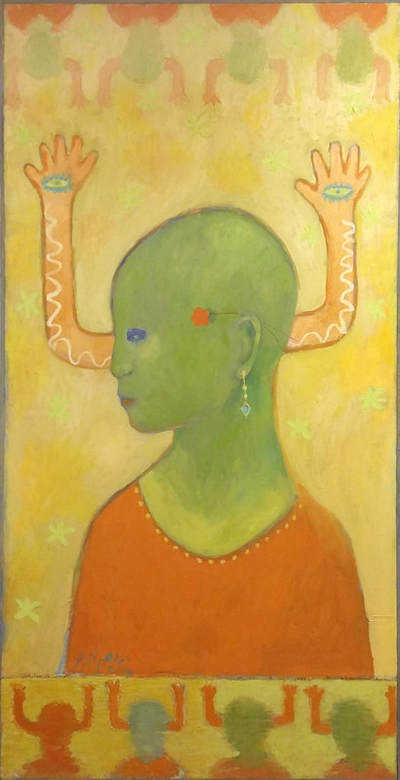|
Ibrahim El Haddad
Ibrahim El Haddad’s immediate environment plays a pivotal role in the direction of his new work. He revels in the spontaneous acts of the Egyptian people that respond to the disorder of the city; such as fashioning furniture out of discarded wood, the creation of new routes around the Egyptian wasteland, or the trail of air-conditioning tubes out of the fifth floor window to water the trees below. It is this inherent creativity of the Cairenes as they improvise with their urban landscape which he refers to as the art of the everyday, and are the adventures of the street that he seeks to retell. Playful structures and found objects are the defining features of his current work, whilst vivid colours pay homage to the vibrancy of the place where he grew up; to the neon lights, the personal embellishments of shops and the kitsch interiors of taxis. Toeing the line between painting and sculpture, he mounts household trinkets and robabikeya onto wooden boards discarded from the rooftops of Cairo. We are reminded of the kiosk owner on the sidewalk whose leftover container is refashioned as a chair. Just as the cities inhabitants improvise with their metropolitan playground, El Haddad imitates these daily acts by repurposing the debris of the streets into his lively constructions. In the selection process for his objects, he relinquishes some control, and allows the objects to choose him as they appear at certain moments and present themselves to him. This almost magical dimension to his work places emphasis on being open to interacting with your surroundings and the affective capacity of everyday matter. By reusing found objects in new ways El Haddad invites us to discover new ways of seeing and to marvel at the commonplace creativity happening on the pavements. Through his work El Haddad challenges the conception of art as separate from the rest of social life. His references to African art - to a culture where art was deeply woven into the very fabric of society, and never intended to be ‘art’ in the institutional sense - prompts us to reflect on the routine appearances of ‘art’ in our own surroundings and explore what is so often overlooked. Paradoxically, in order to highlight art in the sphere of everyday production, EL Haddad knowingly adheres to the art world’s exclusive conception of art and creates art for the gallery setting. This contradiction, however, can be seen to disrupt institutionally ascribed notions of art from the inside by taking advantage of the privileged platform that the gallery offers. In this way, by presenting in the gallery, he reminds us to look outside of the gallery, and take pleasure in the simple things. Born in 1963 in the center of Cairo, Ibrahim El Haddad graduated from College of Fine Art, Helwan University in 1990. A year later he moved to Switzerland on a scholarship, only returning to Cairo two weeks before the 2011 revolution. El Haddad has participated in various group and solo exhibitions worldwide. |
|





















